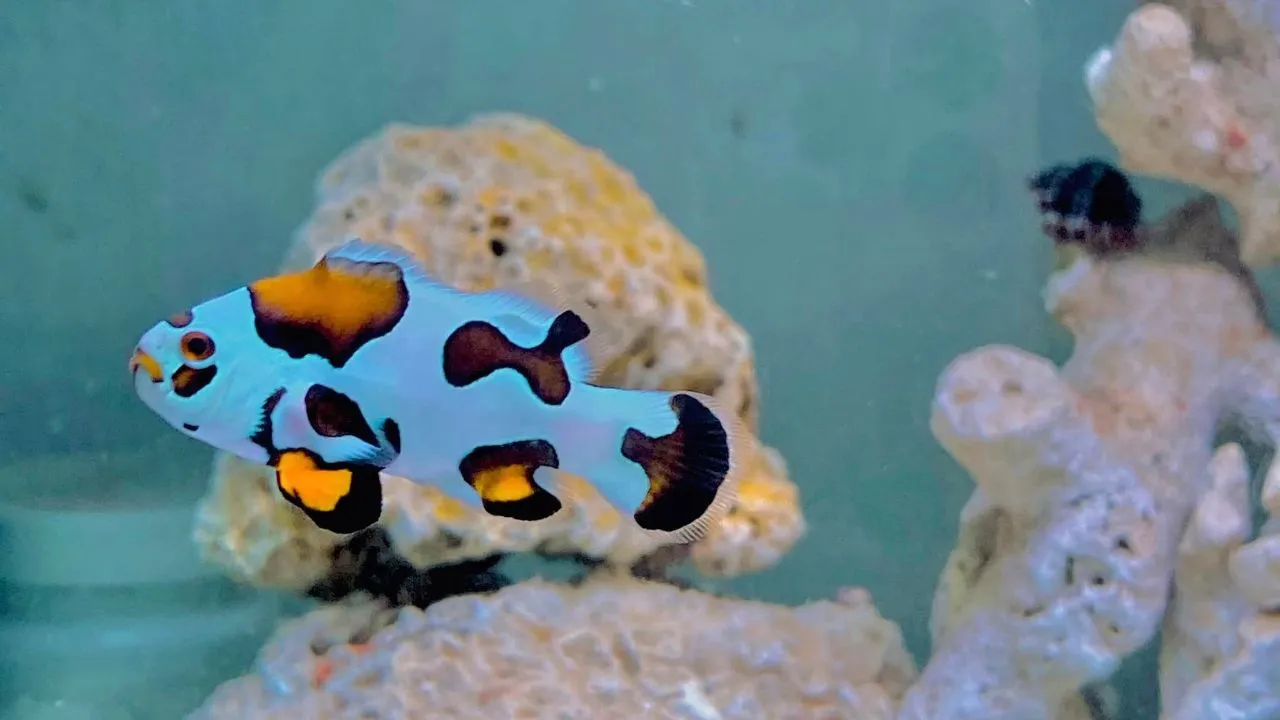How To Get Clownfish To Host Anemone? (9 Easy-to-Follow Tips)

Sea anemones and Clownfish coexist in a symbiotic relationship where the anemone benefits from the Clownfish’s leftovers and the Clownfish obtains protection from predators. However, getting Clownfish to host anemones in captivity can be a bit more challenging. That’s why I’ve compiled a list of 9 easy-to-follow tips to help you encourage your Clownfish to make their home in an anemone. From proper acclimation to selecting the right type of Anemone, this blog post will provide all the information you need to get your Clownfish happily settled in their new home.
9 Easy-to-Follow Tips

Choose The Right Type Of Anemone
Many people make the mistake of purchasing the wrong anemones and hoping their clowns will use them as a host. Not all anemones are suitable for Clownfish, so it’s important to research which species will work best in your tank. The most common types of anemones for Clownfish are the Bubble tip anemone (Entacmaea quadricolor) and the carpet anemone (Stichodactyla gigantea). I highly recommend the bubble-Tip Anemone (Entacmaea quadricolor) for hobbyists. Not only are these anemones beautiful and colorful, but tank-propagated specimens are also common and readily available. In addition, 12+ clownfish species prefer bubble-Tip Anemones as a host.
In spite of the right Clownfish and Anemone, things can get tricky. Your clown may not use the Anemone as a host. In such cases, patience and observation can be key. You may need to use other tricks.
Here is a list of Clownfish preferred anemones.
| Clownfish | Preferred Anemone Type |
|---|---|
| Ocellaris Clownfish (Amphiprion ocellaris) | Bubble Tip Anemone (Entacmaea quadricolor) |
| Maroon Clownfish (Premnas biaculeatus) | Bubble Tip Anemone (Entacmaea quadricolor) |
| Red Saddleback Anemonefish (Amphiprion ephippium) | Bubble Tip Anemone (Entacmaea quadricolor)Sebae |
| Tomato Clownfish (Amphiprion frenatus) | Bubble Tip Anemone (Entacmaea quadricolor) |
| Cinnamon Clownfish (Amphiprion melanopus) | Bubble Tip Anemone (Entacmaea quadricolor) |
| Wide-band Anemonefish (Amphiprion latezonatus) | Sebae anemone/Leathery Sea Anemone(Heteractis crispa) |
| Pink Skunk Clownfish (Amphiprion perideraion) | Sebae anemone/Leathery Sea Anemone(Heteractis crispa) Magnificent sea anemone (usually) Macrodactyla doreensis (Corkscrew Sea Anemone) Stichodactyla gigantea giant carpet anemone |
| Orange clownfish (Amphiprion percula) | Bubble Tip Anemone (Entacmaea quadricolor)Heteractis spp. or carpets |
| Saddleback clownfish/Amphiprion polymnus | Haddon’s Carpet Anemone (Stichodactyla haddoni) Sebae anemone/Leathery Sea Anemone(Heteractis crispa)-(rarely) |
| Sebae Clownfish | Haddon’s Carpet Anemone (Stichodactyla haddoni) Bubble Tip Anemone (Entacmaea quadricolor) Carpets mostly |
| Amphiprion clarkii | Least Host Specific Anemonefish (Carpets mostly) |
Introducing A Sense Of Danger To Your Clownfish
In the wild, Clownfish use anemones for protection, but your Clownfish may not feel the need for an anemone if they are already feeling safe and secure in your aquarium. However, if you want to encourage your Clownfish to use an anemone, you can introduce a sense of danger to their aquarium by adding new fish. This will make the tank feel less like home and may push the Clownfish to seek refuge in an anemone. It’s crucial to remember that using these methods shouldn’t endanger your Clownfish or any other fish.
Placing A Mirror Or Attach A Photograph Of A Clownfish
Some hobbyists have even suggested hanging up pictures of Clownfish in anemones as a way to encourage the fish to host Anemone. By providing your Clownfish with examples of what you would like them to do, they may take the hint and move into the Anemone.
If you’re looking for a quick solution, placing a mirror or photograph outside the tank can make your Clownfish think that other Clownfish have entered its territory, which may cause them to seek refuge in an anemone. This clever trick is designed to give the illusion that another clownfish is trying to invade your Clownfish’s territory, which should make your Clownfish feel threatened enough to seek shelter in the Anemone. While this may seem like a stretch, it’s worth trying.
The Vertical Tube Method
First, place the acrylic tube in the aquarium and gradually move it closer to the Anemone, ensuring a safe distance to avoid any harm to the Clownfish. It’s best to have someone hold the tube steady while you operate to ensure stability. Once the tube is in place, gently scoop some clownfish from the tank and pour them into the tube. Give them some time and let them swim. Eventually, the Clownfish will find its way to the Anemone.
To make the transition as smooth as possible, it’s important to have an acrylic tube that is large enough for the Clownfish to move through comfortably. It’s important to avoid a tube that is too small, as this could cause the Clownfish to become stressed or agitated. The goal is not to harm the fish but to encourage them to seek shelter within the Anemone.
This is an easy and effective method for new Clownfish. What if you already have Clownfish in your reef tank and want them to host a new anemone? Then you need to remove your Clownfish to another tank for a couple of weeks. After sufficient time has passed, reintroduce them to the main reef tank using the tube method.
Enforce Them
Encouraging your Clownfish to move towards the Anemone can be done with a gentle approach, such as using a net or scraper. Another way you can do it is by placing them in a smaller container, such as a clean strainer, and lowering it into the tank. They will be forced to spend time in each other’s company. Sometimes Clownfish may be hesitant or unsure about moving into the Anemone, but with a little extra encouragement, they may be more likely to make a move. The goal is not to force the Clownfish into the Anemone but to guide them and show them where it is.
Temporarily Separate Them From The Main Tank
Remove Anemone from the reef tank and begin acclimating the Anemone to a smaller quarantine tank or sump. Once the Anemone appears settled and content, introduce your Clownfish to the same tank. With fewer distractions, there is a higher likelihood that your Clownfish will choose to host the Anemone. Please keep them in the small tank or sump until your Clownfish chooses to host the Anemone. If the Clownfish does take to the Anemone, it’s time to transfer them back to the main tank. With patience and observation, you may see your Clownfish and Anemone come together in a beautiful partnership.
Bait the Clownfish
According to some experienced fish keepers, You can try to lure the clowns to the Anemone by leading them to it with some food. This will tempt the Clownfish to approach and investigate the Anemone, which may prompt the fish to decide to make it their home. To do this, it is best to substitute sinking granular fish food for floating pellets. Place the food next to the Anemone and observe the Clownfish as they investigate and possibly settle there.
Use Direct Lighting
Shining a light at night over the Anemone brings Clownfish close to the Anemone. It stimulates the Clownfish’s curiosity and attracts them to the Anemone. However, it’s important to be mindful of the lighting you use. Very bright lighting can disrupt the Clownfish’s internal clock and make it difficult for them to tell the difference between night and day. Instead, opt for a low light that will highlight the colors of the Anemone without disrupting the fish’s natural rhythms.
Patience is a Virtue
Be patient. Remember that getting Clownfish to host anemones takes time and patience. Don’t be discouraged if it takes a while for your fish to settle in and form a symbiotic relationship with their anemones.
It’s important to remember that the Clownfish has no set rule to like the Anemone. To ensure the best outcome, monitoring your fish’s behavior and trying different methods closely is important. If you notice that the fish isn’t showing any signs of interest in the Anemone, consider using a net to gently guide the fish towards it, or try the tube method again.
Busting Myths- 1 Tank-Bred Clownfish Will Not Use A Host Anemone
Tank-bred Clownfish can use a host anemone, but they may not always do so spontaneously. Some tank-bred clownfish may not recognize or seek out a host anemone, while others may use one if it is in their tank. The use of a host anemone can also depend on the species of Clownfish.
Tank-bred Clownfish may not have the same instinctual behavior to seek out and use a host anemone. They may not have been exposed to anemones during their development in captivity and may not recognize them as suitable hosts. Additionally, tank-bred Clownfish may not require the protection that a host anemone provides, as the walls of the aquarium already protect them. Overall, tank-bred Clownfish can use a host anemone, but it may not be a guarantee.
Busting Myths- 2 Clownfish Need An Anemone To Survive
This is not entirely true. Despite their symbiotic association with anemones, Clownfish are not dependent on them to live. They use the anemones to protect themselves and to mark their territory, but they may live without them if they can find other types of cover or safety in their surroundings. In addition, Clownfish in aquariums can thrive without anemones.
Final Thoughts
Having Clownfish host anemones in your home aquarium can be a rewarding experience, but it takes some effort to ensure both species are happy and healthy. However, following these 9 easy-to-follow tips can increase your chances of success. With the right approach, you can enjoy your aquarium’s beautiful symbiotic relationship between Clownfish and anemones.
Frequently Asked Questions (FAQ)
Clownfish and anemones have slightly different ideal water conditions but can generally thrive in similar conditions.
For Clownfish, the ideal water conditions include:
Temperature: 72-78°F (22-26°C)
pH: 8.1-8.4
Specific gravity: 1.020-1.025
Ammonia, nitrite, and nitrate levels should be close to zero
For anemones, the ideal water conditions include:
Temperature: 72-78°F (22-26°C)
pH: 8.1-8.4
Specific gravity: 1.020-1.025
Ammonia, nitrite, and nitrate levels should be close to zero
Lighting should be moderate to high, with a mix of blue and white spectrum light.
It depends on the type of aquarium you have and the other clown fishes within it. Here are a few options: Bubble Tip Anemone (Entacmaea quadricolor), Heteractis magnifica, and Sebae anemone/Leathery Sea Anemone (Heteractis crispa).
Anemones should be introduced to an established aquarium with stable water parameters because they can be sensitive to changes in water conditions. Before adding a clownfish to your aquarium, it’s also critical to research its particular needs.
Clownfish can host anemones in as little as a few days or as long as a few weeks. The availability of a suitable anemone for the Clownfish to host, the species of Clownfish and Anemone, and other variables will all affect the precise date.
Recommended Readings!
How To Reduce Clownfish Aggression?
How To Tell If A Clownfish Is Pregnant?
